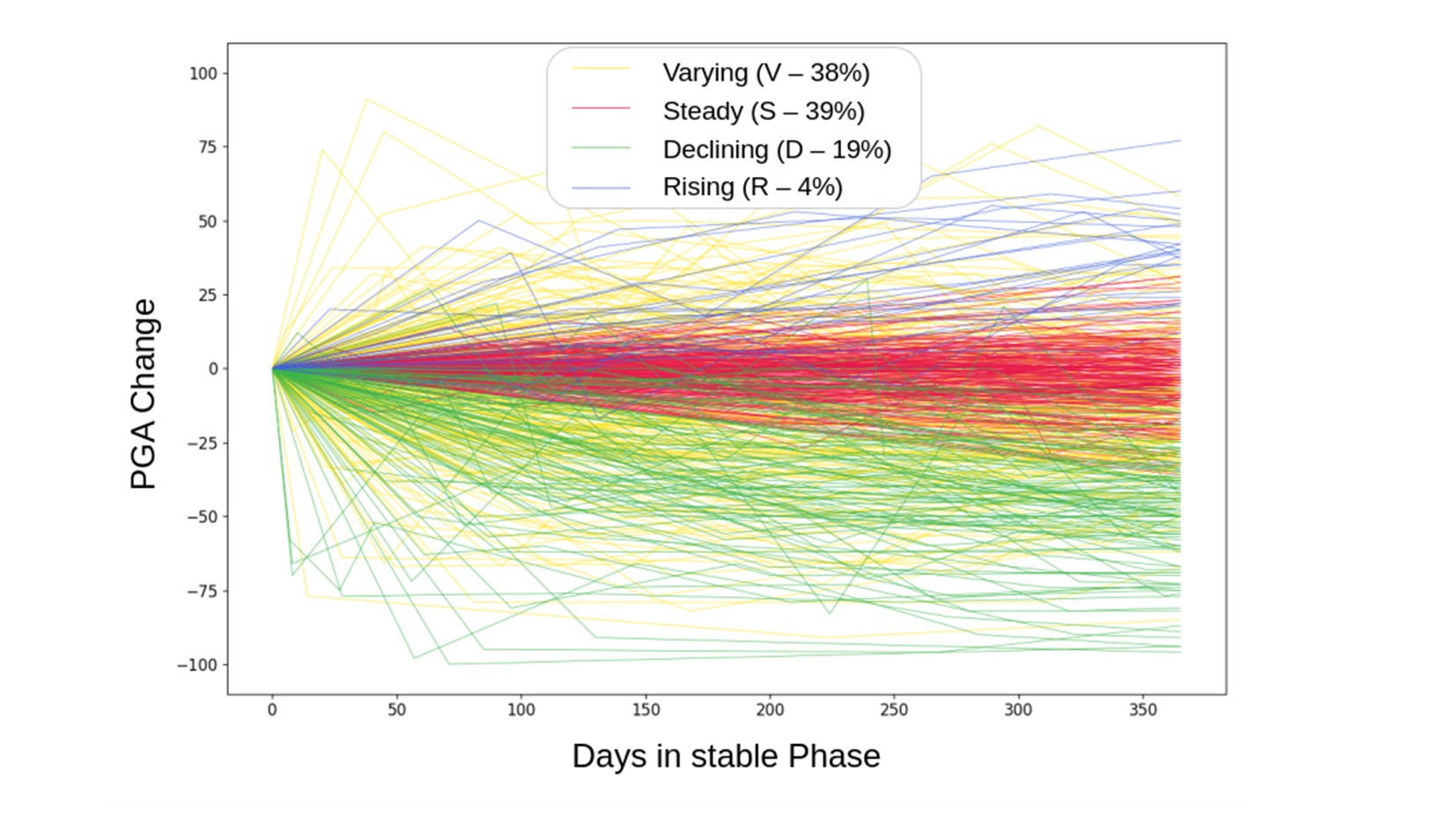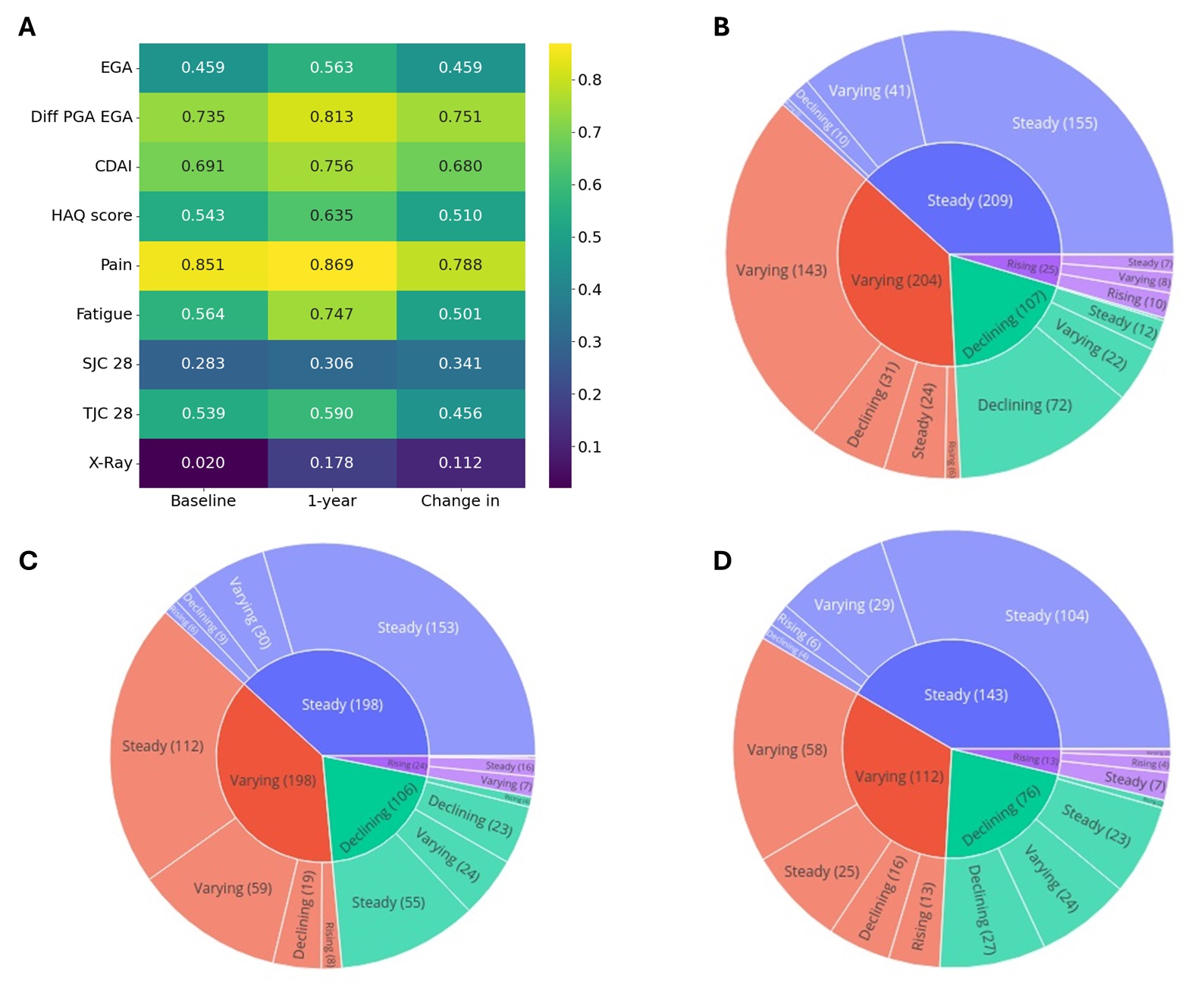Session Information
Session Type: Poster Session C
Session Time: 10:30AM-12:30PM
Background/Purpose: In patients with rheumatoid arthritis (RA), we often see a disconnect between patient and evaluator perceived disease activity. In this study we aim to assess how patient reported outcomes (PRO) behave in a phase of stable disease activity defined as robust evaluator assessed disease activity (EGA) without DMARD change, by identifying trajectories of patient global assessment of disease activity (PGA).
Methods: Clinical data of patients with RA from our observational registry has been retrieved. Stable phase of disease was defined as no change in DMARD treatment AND no meaningful change in EGA of +/-20mm within a time frame of one year. In case of multiple stable phases within a specific patient journey, the most recent phase was analyzed. For the main analyses we considered the first year of the stable period and imputed data at one year based on a linear regression. Trajectories of PROs including PGA, VAS pain, HAQ and VAS fatigue within the stable phase were identified by either linear or continuous, piecewise regression function. We compared clinical characteristics of patients by different trajectories based on PGA. Pearson correlation between core outcomes and PGA and agreement analyses (kappa) of PGA strata with trajectories of pain, fatigue and HAQ have been performed.
Results: Out of 1552 patients, 545 (35%) patients had at least one stable phase, with 76% female, mean disease duration 5.0±6.4 years, mean age 67.86±15.1 years, mean CDAI 16.7±12.1. We could identify 4 different trajectories based on PGA: steady S n=210; varying V n=206, rising R n=23 and declining D n=106, Figure 1) Overall, patients with declining PGA trajectory had higher values of disease activity at beginning of a stable phase compared to all other groups. CDAI in the D strata was higher (20±12.8 vs 16±12.1) at baseline and lower at the endpoint (6.5±7.6 vs. 10.3±9.8) compared to all. The R strata had the highest rate of comorbidities, with none of the patients having only RA. The change in PGA was different to the overall group in both the R and D, however the D shows a change of -3.4±4.4 in SJC28, which was only -0.61±S2.1 for the R respectively. The mean difference between PGA and EGA did not change from beginning to end of stable phase (19.2±25.2 vs. 18.7±20.5) but was reversed in patients of rising compared to declining PGA trajectories: PGA-EGA at baseline: D: 27.1±26.1, R: 1.8±12.7 vs. PGA-EGA at year 1: D 8.7±13.6, R 35.6±23.3.
Correlation of PGA with other PRO was high throughout the stable phase and moderate to low with TJC28, EGA and SJC28 (Figure 2A). The sunburst plots (Figure 2B-D) visualize the agreement of PGA trajectories with trajectories of pain (2B, kappa: 0.55), fatigue (2C, kappa: 0.35) or HAQ (2D, kappa: 0.15). The risk of discrepancy of PGA trajectory with more than one other PRO trajectory was lowest in S (24%) and highest in R (76%).
Conclusion: We could show that in a one-year timeframe of a stable phase of disease activity defined by the evaluator, the majority of PRO fluctuate. Even if PROs highly correlate with the PGA, not all changes would be concordantly, indicating that distinct outcomes flag the need for individual interventions beyond DMARD treatment.
To cite this abstract in AMA style:
Studenic P, Schwab N, Zauner G, Tran T, Lechner-Radner H. Different Trajectories of Patient Reported Outcomes in Patients with RA in a Stable Phase of Disease – an Observational Study [abstract]. Arthritis Rheumatol. 2024; 76 (suppl 9). https://acrabstracts.org/abstract/different-trajectories-of-patient-reported-outcomes-in-patients-with-ra-in-a-stable-phase-of-disease-an-observational-study/. Accessed .« Back to ACR Convergence 2024
ACR Meeting Abstracts - https://acrabstracts.org/abstract/different-trajectories-of-patient-reported-outcomes-in-patients-with-ra-in-a-stable-phase-of-disease-an-observational-study/


